Gender and Homosexuality in Christianity and Islam
VerifiedAdded on 2023/06/13
|10
|2789
|62
AI Summary
This article discusses the status of women and homosexuality in Christianity and Islam, with references to the Old Testament, New Testament, and Quran. It explores the subjugation of women and the criminalization of homosexuality, and how these beliefs have been used to justify oppression and persecution. It also discusses the changes in the status of women during the medieval period, and the current situation in the Middle East. Course code and college/university not mentioned.
Contribute Materials
Your contribution can guide someone’s learning journey. Share your
documents today.
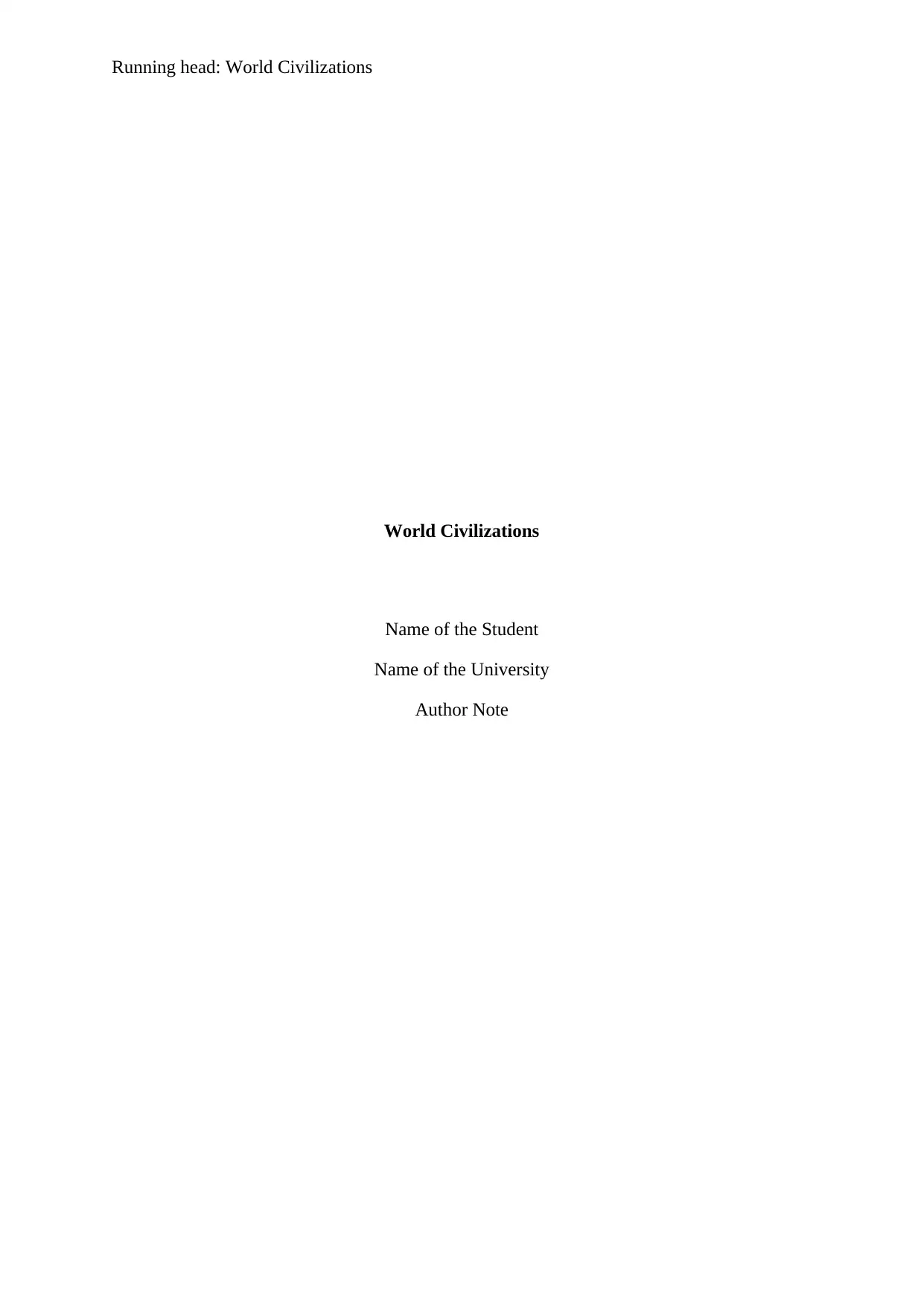
Running head: World Civilizations
World Civilizations
Name of the Student
Name of the University
Author Note
World Civilizations
Name of the Student
Name of the University
Author Note
Secure Best Marks with AI Grader
Need help grading? Try our AI Grader for instant feedback on your assignments.
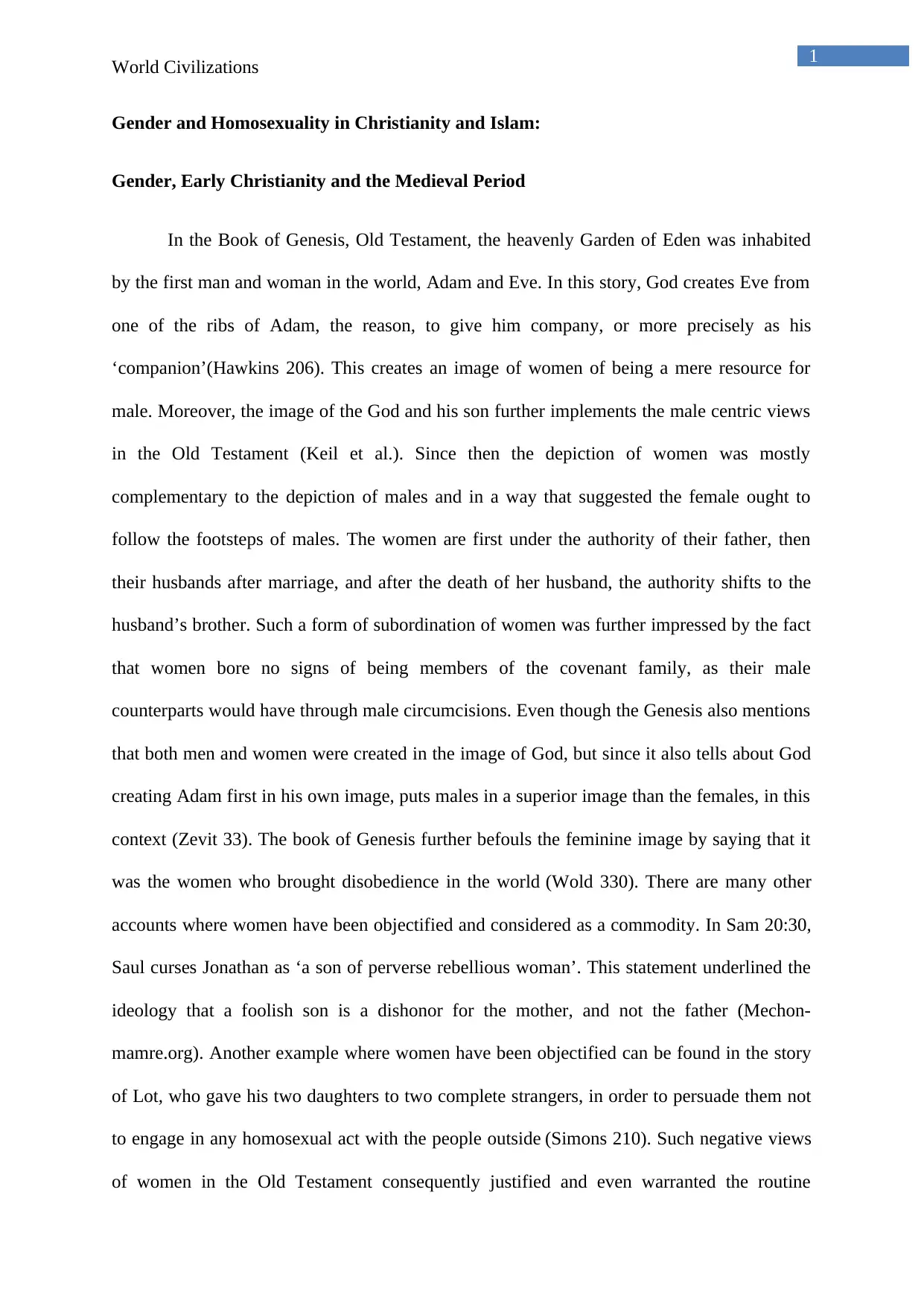
1
World Civilizations
Gender and Homosexuality in Christianity and Islam:
Gender, Early Christianity and the Medieval Period
In the Book of Genesis, Old Testament, the heavenly Garden of Eden was inhabited
by the first man and woman in the world, Adam and Eve. In this story, God creates Eve from
one of the ribs of Adam, the reason, to give him company, or more precisely as his
‘companion’(Hawkins 206). This creates an image of women of being a mere resource for
male. Moreover, the image of the God and his son further implements the male centric views
in the Old Testament (Keil et al.). Since then the depiction of women was mostly
complementary to the depiction of males and in a way that suggested the female ought to
follow the footsteps of males. The women are first under the authority of their father, then
their husbands after marriage, and after the death of her husband, the authority shifts to the
husband’s brother. Such a form of subordination of women was further impressed by the fact
that women bore no signs of being members of the covenant family, as their male
counterparts would have through male circumcisions. Even though the Genesis also mentions
that both men and women were created in the image of God, but since it also tells about God
creating Adam first in his own image, puts males in a superior image than the females, in this
context (Zevit 33). The book of Genesis further befouls the feminine image by saying that it
was the women who brought disobedience in the world (Wold 330). There are many other
accounts where women have been objectified and considered as a commodity. In Sam 20:30,
Saul curses Jonathan as ‘a son of perverse rebellious woman’. This statement underlined the
ideology that a foolish son is a dishonor for the mother, and not the father (Mechon-
mamre.org). Another example where women have been objectified can be found in the story
of Lot, who gave his two daughters to two complete strangers, in order to persuade them not
to engage in any homosexual act with the people outside (Simons 210). Such negative views
of women in the Old Testament consequently justified and even warranted the routine
World Civilizations
Gender and Homosexuality in Christianity and Islam:
Gender, Early Christianity and the Medieval Period
In the Book of Genesis, Old Testament, the heavenly Garden of Eden was inhabited
by the first man and woman in the world, Adam and Eve. In this story, God creates Eve from
one of the ribs of Adam, the reason, to give him company, or more precisely as his
‘companion’(Hawkins 206). This creates an image of women of being a mere resource for
male. Moreover, the image of the God and his son further implements the male centric views
in the Old Testament (Keil et al.). Since then the depiction of women was mostly
complementary to the depiction of males and in a way that suggested the female ought to
follow the footsteps of males. The women are first under the authority of their father, then
their husbands after marriage, and after the death of her husband, the authority shifts to the
husband’s brother. Such a form of subordination of women was further impressed by the fact
that women bore no signs of being members of the covenant family, as their male
counterparts would have through male circumcisions. Even though the Genesis also mentions
that both men and women were created in the image of God, but since it also tells about God
creating Adam first in his own image, puts males in a superior image than the females, in this
context (Zevit 33). The book of Genesis further befouls the feminine image by saying that it
was the women who brought disobedience in the world (Wold 330). There are many other
accounts where women have been objectified and considered as a commodity. In Sam 20:30,
Saul curses Jonathan as ‘a son of perverse rebellious woman’. This statement underlined the
ideology that a foolish son is a dishonor for the mother, and not the father (Mechon-
mamre.org). Another example where women have been objectified can be found in the story
of Lot, who gave his two daughters to two complete strangers, in order to persuade them not
to engage in any homosexual act with the people outside (Simons 210). Such negative views
of women in the Old Testament consequently justified and even warranted the routine
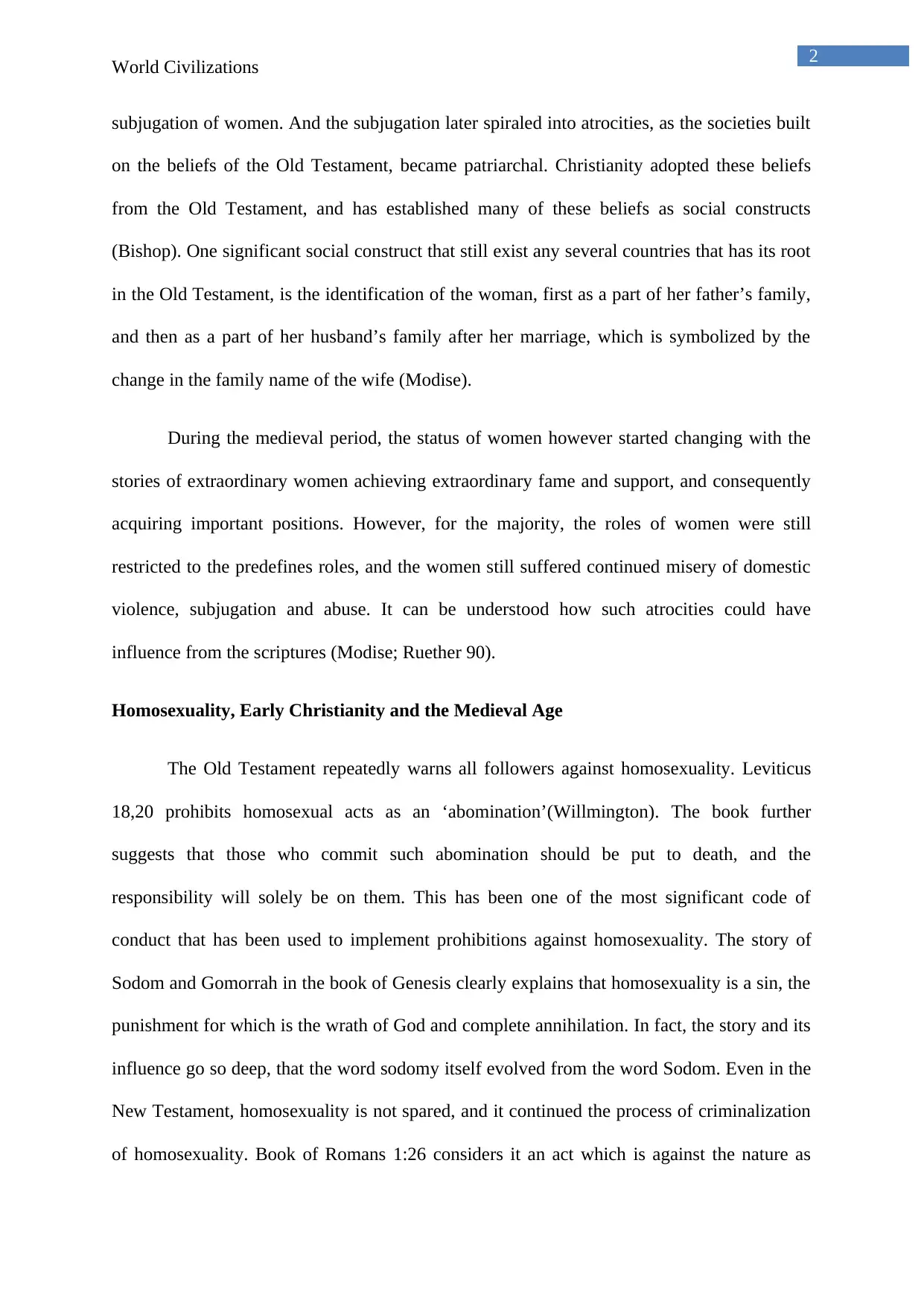
2
World Civilizations
subjugation of women. And the subjugation later spiraled into atrocities, as the societies built
on the beliefs of the Old Testament, became patriarchal. Christianity adopted these beliefs
from the Old Testament, and has established many of these beliefs as social constructs
(Bishop). One significant social construct that still exist any several countries that has its root
in the Old Testament, is the identification of the woman, first as a part of her father’s family,
and then as a part of her husband’s family after her marriage, which is symbolized by the
change in the family name of the wife (Modise).
During the medieval period, the status of women however started changing with the
stories of extraordinary women achieving extraordinary fame and support, and consequently
acquiring important positions. However, for the majority, the roles of women were still
restricted to the predefines roles, and the women still suffered continued misery of domestic
violence, subjugation and abuse. It can be understood how such atrocities could have
influence from the scriptures (Modise; Ruether 90).
Homosexuality, Early Christianity and the Medieval Age
The Old Testament repeatedly warns all followers against homosexuality. Leviticus
18,20 prohibits homosexual acts as an ‘abomination’(Willmington). The book further
suggests that those who commit such abomination should be put to death, and the
responsibility will solely be on them. This has been one of the most significant code of
conduct that has been used to implement prohibitions against homosexuality. The story of
Sodom and Gomorrah in the book of Genesis clearly explains that homosexuality is a sin, the
punishment for which is the wrath of God and complete annihilation. In fact, the story and its
influence go so deep, that the word sodomy itself evolved from the word Sodom. Even in the
New Testament, homosexuality is not spared, and it continued the process of criminalization
of homosexuality. Book of Romans 1:26 considers it an act which is against the nature as
World Civilizations
subjugation of women. And the subjugation later spiraled into atrocities, as the societies built
on the beliefs of the Old Testament, became patriarchal. Christianity adopted these beliefs
from the Old Testament, and has established many of these beliefs as social constructs
(Bishop). One significant social construct that still exist any several countries that has its root
in the Old Testament, is the identification of the woman, first as a part of her father’s family,
and then as a part of her husband’s family after her marriage, which is symbolized by the
change in the family name of the wife (Modise).
During the medieval period, the status of women however started changing with the
stories of extraordinary women achieving extraordinary fame and support, and consequently
acquiring important positions. However, for the majority, the roles of women were still
restricted to the predefines roles, and the women still suffered continued misery of domestic
violence, subjugation and abuse. It can be understood how such atrocities could have
influence from the scriptures (Modise; Ruether 90).
Homosexuality, Early Christianity and the Medieval Age
The Old Testament repeatedly warns all followers against homosexuality. Leviticus
18,20 prohibits homosexual acts as an ‘abomination’(Willmington). The book further
suggests that those who commit such abomination should be put to death, and the
responsibility will solely be on them. This has been one of the most significant code of
conduct that has been used to implement prohibitions against homosexuality. The story of
Sodom and Gomorrah in the book of Genesis clearly explains that homosexuality is a sin, the
punishment for which is the wrath of God and complete annihilation. In fact, the story and its
influence go so deep, that the word sodomy itself evolved from the word Sodom. Even in the
New Testament, homosexuality is not spared, and it continued the process of criminalization
of homosexuality. Book of Romans 1:26 considers it an act which is against the nature as
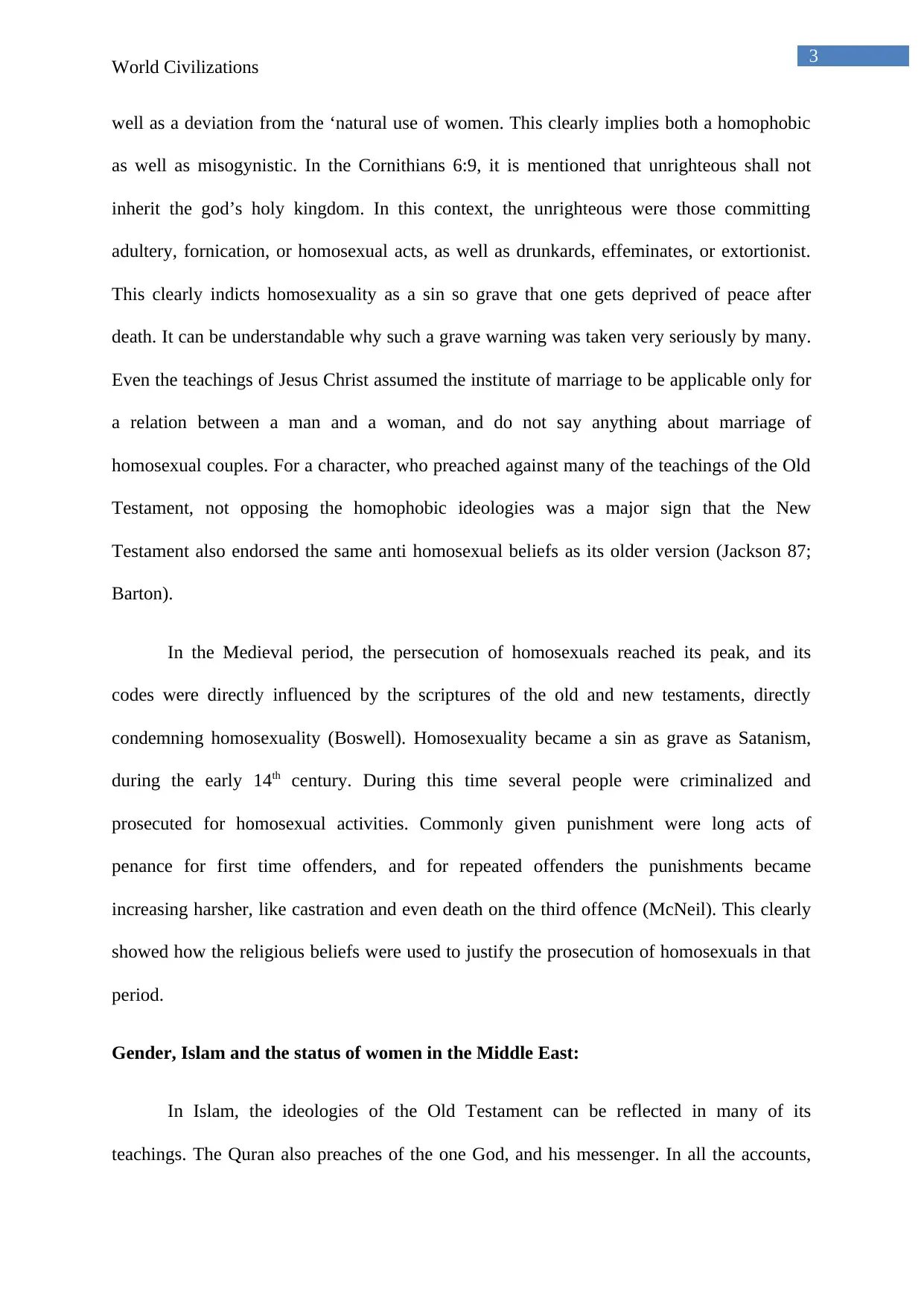
3
World Civilizations
well as a deviation from the ‘natural use of women. This clearly implies both a homophobic
as well as misogynistic. In the Cornithians 6:9, it is mentioned that unrighteous shall not
inherit the god’s holy kingdom. In this context, the unrighteous were those committing
adultery, fornication, or homosexual acts, as well as drunkards, effeminates, or extortionist.
This clearly indicts homosexuality as a sin so grave that one gets deprived of peace after
death. It can be understandable why such a grave warning was taken very seriously by many.
Even the teachings of Jesus Christ assumed the institute of marriage to be applicable only for
a relation between a man and a woman, and do not say anything about marriage of
homosexual couples. For a character, who preached against many of the teachings of the Old
Testament, not opposing the homophobic ideologies was a major sign that the New
Testament also endorsed the same anti homosexual beliefs as its older version (Jackson 87;
Barton).
In the Medieval period, the persecution of homosexuals reached its peak, and its
codes were directly influenced by the scriptures of the old and new testaments, directly
condemning homosexuality (Boswell). Homosexuality became a sin as grave as Satanism,
during the early 14th century. During this time several people were criminalized and
prosecuted for homosexual activities. Commonly given punishment were long acts of
penance for first time offenders, and for repeated offenders the punishments became
increasing harsher, like castration and even death on the third offence (McNeil). This clearly
showed how the religious beliefs were used to justify the prosecution of homosexuals in that
period.
Gender, Islam and the status of women in the Middle East:
In Islam, the ideologies of the Old Testament can be reflected in many of its
teachings. The Quran also preaches of the one God, and his messenger. In all the accounts,
World Civilizations
well as a deviation from the ‘natural use of women. This clearly implies both a homophobic
as well as misogynistic. In the Cornithians 6:9, it is mentioned that unrighteous shall not
inherit the god’s holy kingdom. In this context, the unrighteous were those committing
adultery, fornication, or homosexual acts, as well as drunkards, effeminates, or extortionist.
This clearly indicts homosexuality as a sin so grave that one gets deprived of peace after
death. It can be understandable why such a grave warning was taken very seriously by many.
Even the teachings of Jesus Christ assumed the institute of marriage to be applicable only for
a relation between a man and a woman, and do not say anything about marriage of
homosexual couples. For a character, who preached against many of the teachings of the Old
Testament, not opposing the homophobic ideologies was a major sign that the New
Testament also endorsed the same anti homosexual beliefs as its older version (Jackson 87;
Barton).
In the Medieval period, the persecution of homosexuals reached its peak, and its
codes were directly influenced by the scriptures of the old and new testaments, directly
condemning homosexuality (Boswell). Homosexuality became a sin as grave as Satanism,
during the early 14th century. During this time several people were criminalized and
prosecuted for homosexual activities. Commonly given punishment were long acts of
penance for first time offenders, and for repeated offenders the punishments became
increasing harsher, like castration and even death on the third offence (McNeil). This clearly
showed how the religious beliefs were used to justify the prosecution of homosexuals in that
period.
Gender, Islam and the status of women in the Middle East:
In Islam, the ideologies of the Old Testament can be reflected in many of its
teachings. The Quran also preaches of the one God, and his messenger. In all the accounts,
Secure Best Marks with AI Grader
Need help grading? Try our AI Grader for instant feedback on your assignments.
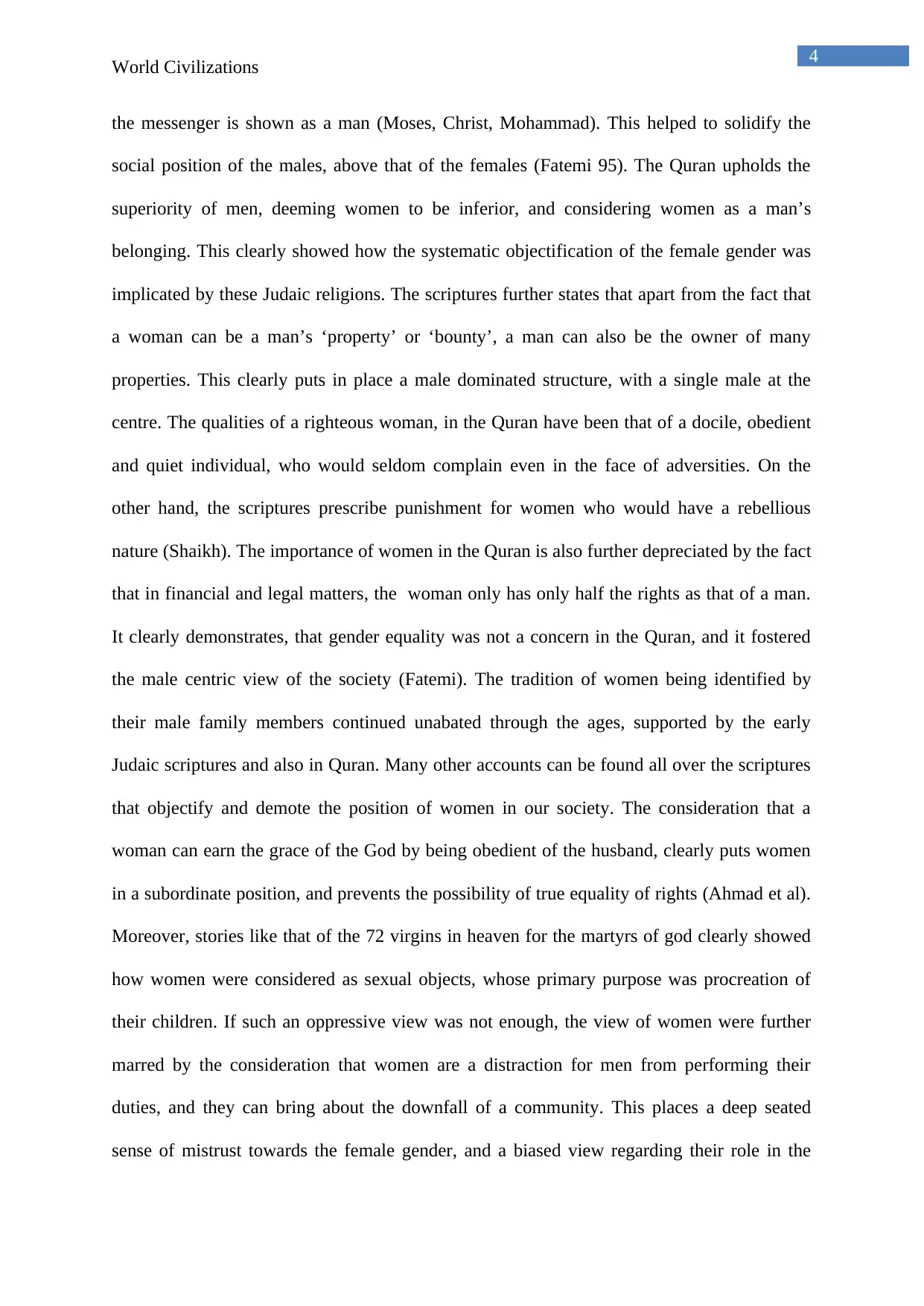
4
World Civilizations
the messenger is shown as a man (Moses, Christ, Mohammad). This helped to solidify the
social position of the males, above that of the females (Fatemi 95). The Quran upholds the
superiority of men, deeming women to be inferior, and considering women as a man’s
belonging. This clearly showed how the systematic objectification of the female gender was
implicated by these Judaic religions. The scriptures further states that apart from the fact that
a woman can be a man’s ‘property’ or ‘bounty’, a man can also be the owner of many
properties. This clearly puts in place a male dominated structure, with a single male at the
centre. The qualities of a righteous woman, in the Quran have been that of a docile, obedient
and quiet individual, who would seldom complain even in the face of adversities. On the
other hand, the scriptures prescribe punishment for women who would have a rebellious
nature (Shaikh). The importance of women in the Quran is also further depreciated by the fact
that in financial and legal matters, the woman only has only half the rights as that of a man.
It clearly demonstrates, that gender equality was not a concern in the Quran, and it fostered
the male centric view of the society (Fatemi). The tradition of women being identified by
their male family members continued unabated through the ages, supported by the early
Judaic scriptures and also in Quran. Many other accounts can be found all over the scriptures
that objectify and demote the position of women in our society. The consideration that a
woman can earn the grace of the God by being obedient of the husband, clearly puts women
in a subordinate position, and prevents the possibility of true equality of rights (Ahmad et al).
Moreover, stories like that of the 72 virgins in heaven for the martyrs of god clearly showed
how women were considered as sexual objects, whose primary purpose was procreation of
their children. If such an oppressive view was not enough, the view of women were further
marred by the consideration that women are a distraction for men from performing their
duties, and they can bring about the downfall of a community. This places a deep seated
sense of mistrust towards the female gender, and a biased view regarding their role in the
World Civilizations
the messenger is shown as a man (Moses, Christ, Mohammad). This helped to solidify the
social position of the males, above that of the females (Fatemi 95). The Quran upholds the
superiority of men, deeming women to be inferior, and considering women as a man’s
belonging. This clearly showed how the systematic objectification of the female gender was
implicated by these Judaic religions. The scriptures further states that apart from the fact that
a woman can be a man’s ‘property’ or ‘bounty’, a man can also be the owner of many
properties. This clearly puts in place a male dominated structure, with a single male at the
centre. The qualities of a righteous woman, in the Quran have been that of a docile, obedient
and quiet individual, who would seldom complain even in the face of adversities. On the
other hand, the scriptures prescribe punishment for women who would have a rebellious
nature (Shaikh). The importance of women in the Quran is also further depreciated by the fact
that in financial and legal matters, the woman only has only half the rights as that of a man.
It clearly demonstrates, that gender equality was not a concern in the Quran, and it fostered
the male centric view of the society (Fatemi). The tradition of women being identified by
their male family members continued unabated through the ages, supported by the early
Judaic scriptures and also in Quran. Many other accounts can be found all over the scriptures
that objectify and demote the position of women in our society. The consideration that a
woman can earn the grace of the God by being obedient of the husband, clearly puts women
in a subordinate position, and prevents the possibility of true equality of rights (Ahmad et al).
Moreover, stories like that of the 72 virgins in heaven for the martyrs of god clearly showed
how women were considered as sexual objects, whose primary purpose was procreation of
their children. If such an oppressive view was not enough, the view of women were further
marred by the consideration that women are a distraction for men from performing their
duties, and they can bring about the downfall of a community. This places a deep seated
sense of mistrust towards the female gender, and a biased view regarding their role in the
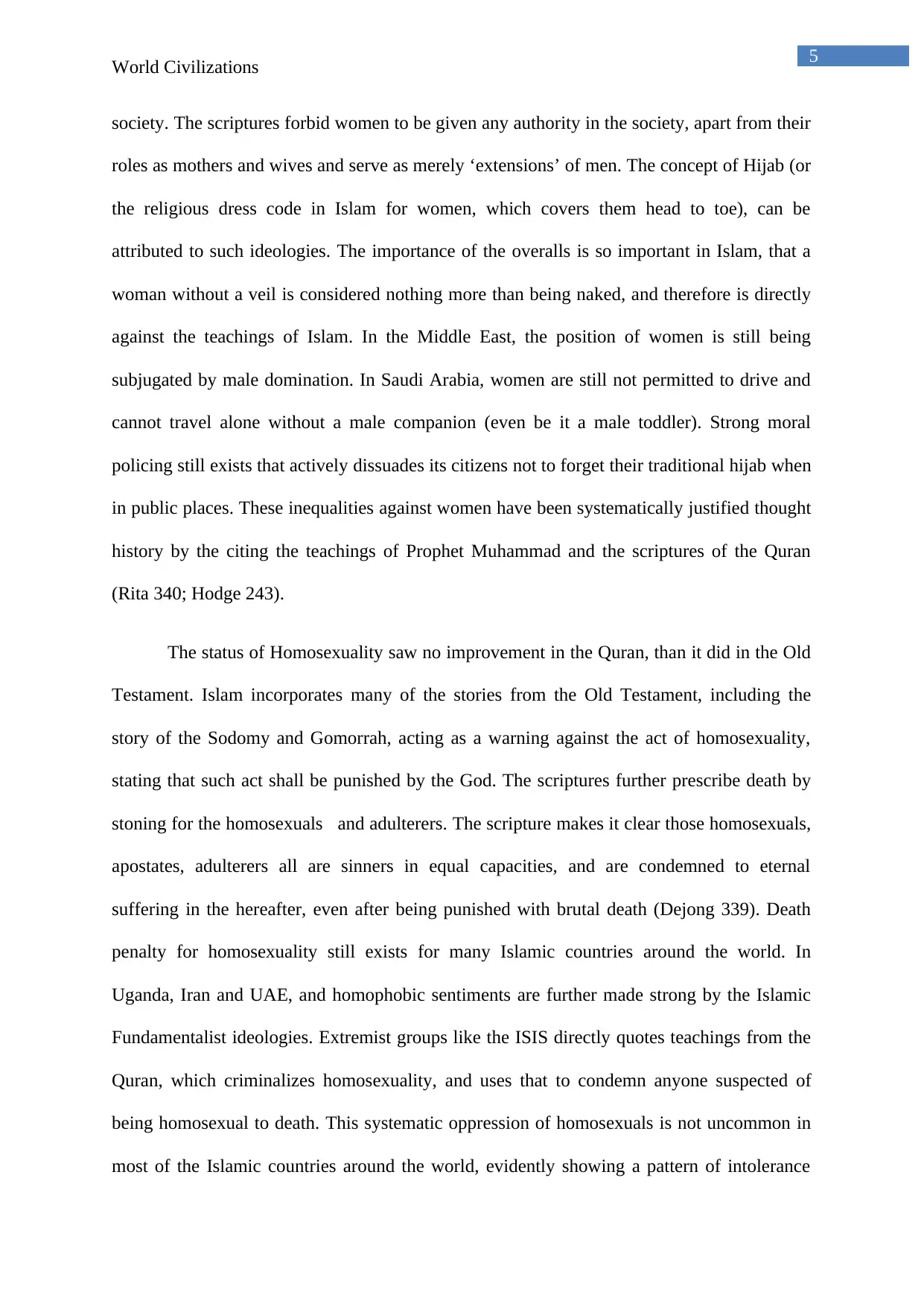
5
World Civilizations
society. The scriptures forbid women to be given any authority in the society, apart from their
roles as mothers and wives and serve as merely ‘extensions’ of men. The concept of Hijab (or
the religious dress code in Islam for women, which covers them head to toe), can be
attributed to such ideologies. The importance of the overalls is so important in Islam, that a
woman without a veil is considered nothing more than being naked, and therefore is directly
against the teachings of Islam. In the Middle East, the position of women is still being
subjugated by male domination. In Saudi Arabia, women are still not permitted to drive and
cannot travel alone without a male companion (even be it a male toddler). Strong moral
policing still exists that actively dissuades its citizens not to forget their traditional hijab when
in public places. These inequalities against women have been systematically justified thought
history by the citing the teachings of Prophet Muhammad and the scriptures of the Quran
(Rita 340; Hodge 243).
The status of Homosexuality saw no improvement in the Quran, than it did in the Old
Testament. Islam incorporates many of the stories from the Old Testament, including the
story of the Sodomy and Gomorrah, acting as a warning against the act of homosexuality,
stating that such act shall be punished by the God. The scriptures further prescribe death by
stoning for the homosexuals and adulterers. The scripture makes it clear those homosexuals,
apostates, adulterers all are sinners in equal capacities, and are condemned to eternal
suffering in the hereafter, even after being punished with brutal death (Dejong 339). Death
penalty for homosexuality still exists for many Islamic countries around the world. In
Uganda, Iran and UAE, and homophobic sentiments are further made strong by the Islamic
Fundamentalist ideologies. Extremist groups like the ISIS directly quotes teachings from the
Quran, which criminalizes homosexuality, and uses that to condemn anyone suspected of
being homosexual to death. This systematic oppression of homosexuals is not uncommon in
most of the Islamic countries around the world, evidently showing a pattern of intolerance
World Civilizations
society. The scriptures forbid women to be given any authority in the society, apart from their
roles as mothers and wives and serve as merely ‘extensions’ of men. The concept of Hijab (or
the religious dress code in Islam for women, which covers them head to toe), can be
attributed to such ideologies. The importance of the overalls is so important in Islam, that a
woman without a veil is considered nothing more than being naked, and therefore is directly
against the teachings of Islam. In the Middle East, the position of women is still being
subjugated by male domination. In Saudi Arabia, women are still not permitted to drive and
cannot travel alone without a male companion (even be it a male toddler). Strong moral
policing still exists that actively dissuades its citizens not to forget their traditional hijab when
in public places. These inequalities against women have been systematically justified thought
history by the citing the teachings of Prophet Muhammad and the scriptures of the Quran
(Rita 340; Hodge 243).
The status of Homosexuality saw no improvement in the Quran, than it did in the Old
Testament. Islam incorporates many of the stories from the Old Testament, including the
story of the Sodomy and Gomorrah, acting as a warning against the act of homosexuality,
stating that such act shall be punished by the God. The scriptures further prescribe death by
stoning for the homosexuals and adulterers. The scripture makes it clear those homosexuals,
apostates, adulterers all are sinners in equal capacities, and are condemned to eternal
suffering in the hereafter, even after being punished with brutal death (Dejong 339). Death
penalty for homosexuality still exists for many Islamic countries around the world. In
Uganda, Iran and UAE, and homophobic sentiments are further made strong by the Islamic
Fundamentalist ideologies. Extremist groups like the ISIS directly quotes teachings from the
Quran, which criminalizes homosexuality, and uses that to condemn anyone suspected of
being homosexual to death. This systematic oppression of homosexuals is not uncommon in
most of the Islamic countries around the world, evidently showing a pattern of intolerance
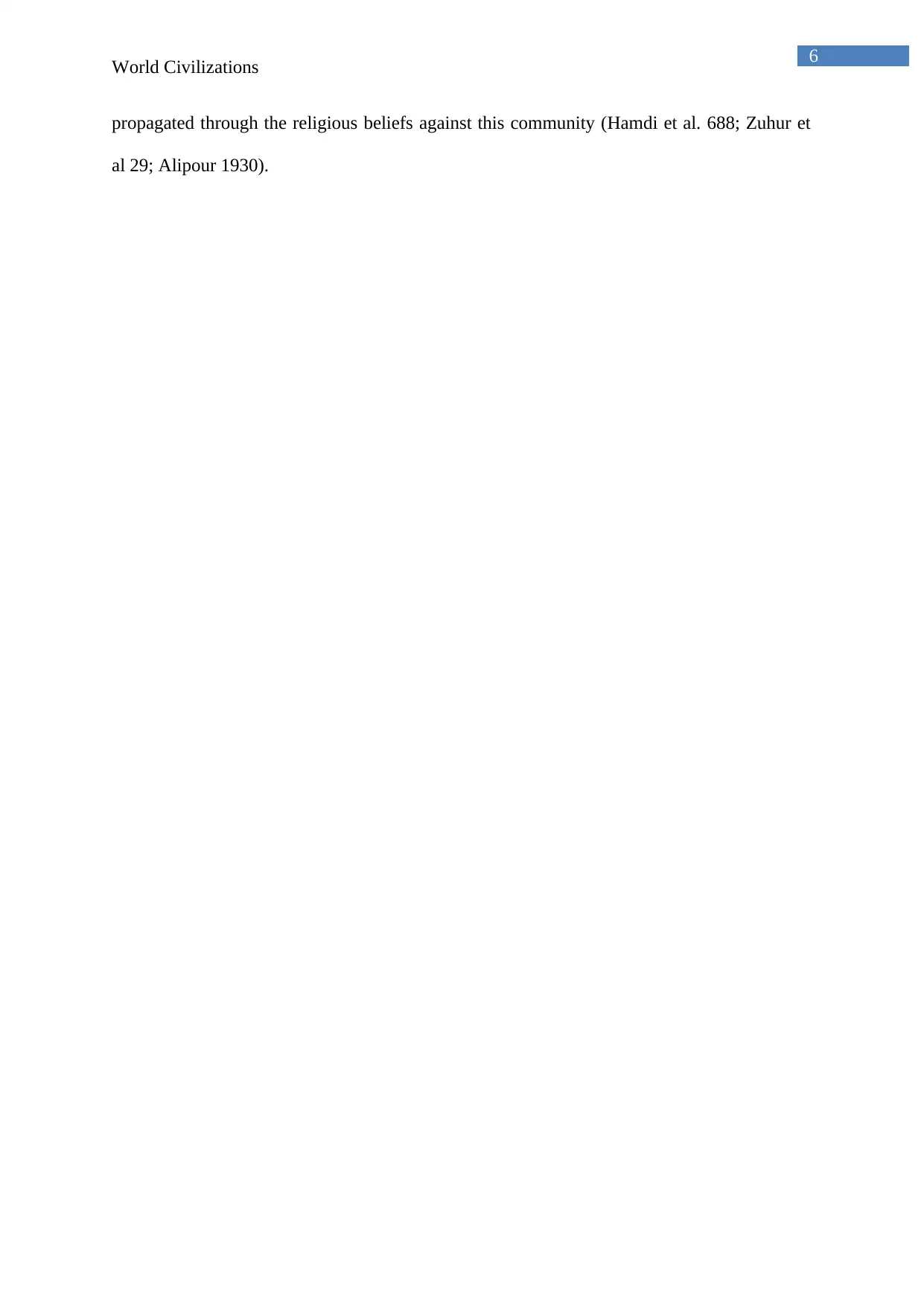
6
World Civilizations
propagated through the religious beliefs against this community (Hamdi et al. 688; Zuhur et
al 29; Alipour 1930).
World Civilizations
propagated through the religious beliefs against this community (Hamdi et al. 688; Zuhur et
al 29; Alipour 1930).
Paraphrase This Document
Need a fresh take? Get an instant paraphrase of this document with our AI Paraphraser
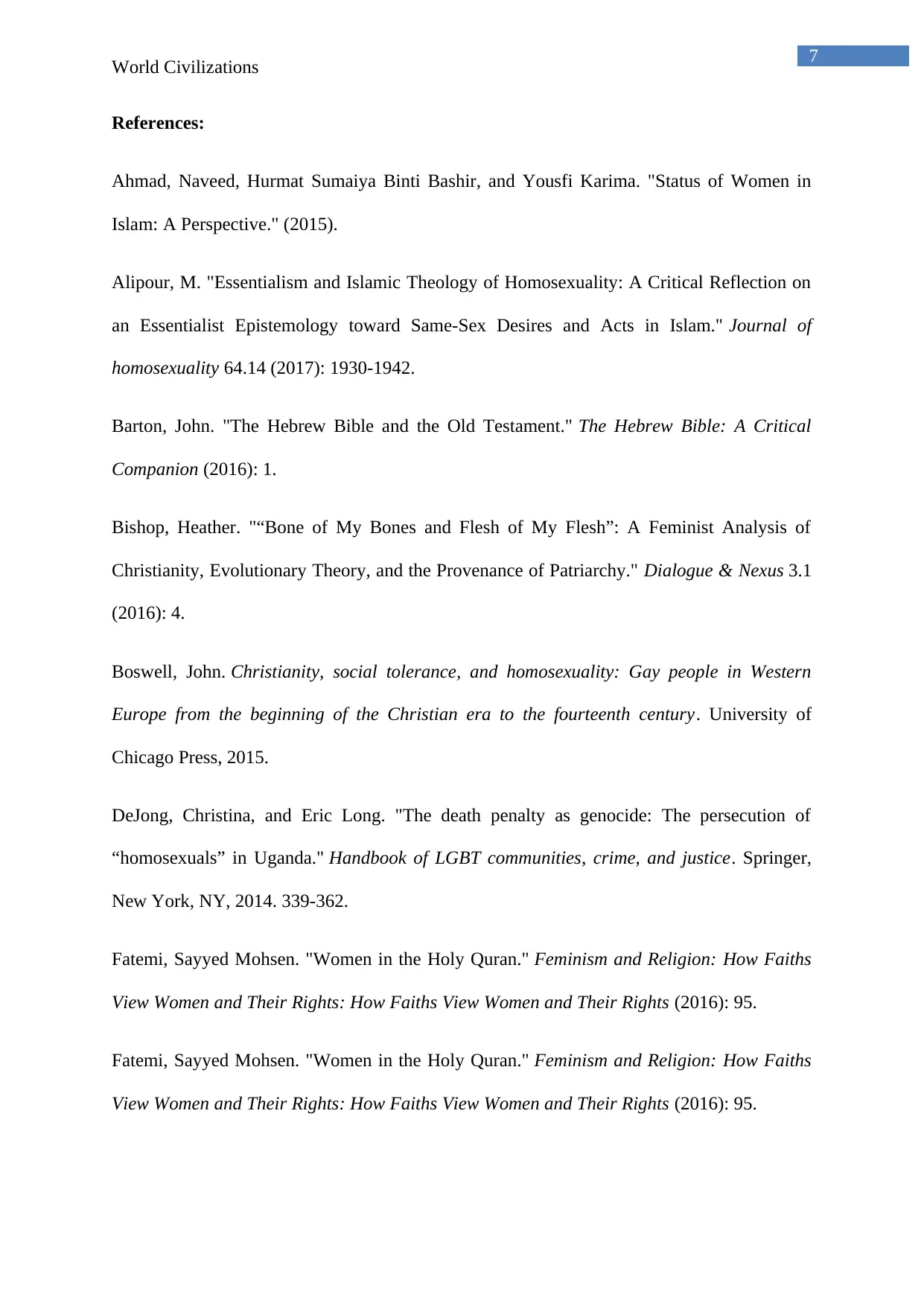
7
World Civilizations
References:
Ahmad, Naveed, Hurmat Sumaiya Binti Bashir, and Yousfi Karima. "Status of Women in
Islam: A Perspective." (2015).
Alipour, M. "Essentialism and Islamic Theology of Homosexuality: A Critical Reflection on
an Essentialist Epistemology toward Same-Sex Desires and Acts in Islam." Journal of
homosexuality 64.14 (2017): 1930-1942.
Barton, John. "The Hebrew Bible and the Old Testament." The Hebrew Bible: A Critical
Companion (2016): 1.
Bishop, Heather. "“Bone of My Bones and Flesh of My Flesh”: A Feminist Analysis of
Christianity, Evolutionary Theory, and the Provenance of Patriarchy." Dialogue & Nexus 3.1
(2016): 4.
Boswell, John. Christianity, social tolerance, and homosexuality: Gay people in Western
Europe from the beginning of the Christian era to the fourteenth century. University of
Chicago Press, 2015.
DeJong, Christina, and Eric Long. "The death penalty as genocide: The persecution of
“homosexuals” in Uganda." Handbook of LGBT communities, crime, and justice. Springer,
New York, NY, 2014. 339-362.
Fatemi, Sayyed Mohsen. "Women in the Holy Quran." Feminism and Religion: How Faiths
View Women and Their Rights: How Faiths View Women and Their Rights (2016): 95.
Fatemi, Sayyed Mohsen. "Women in the Holy Quran." Feminism and Religion: How Faiths
View Women and Their Rights: How Faiths View Women and Their Rights (2016): 95.
World Civilizations
References:
Ahmad, Naveed, Hurmat Sumaiya Binti Bashir, and Yousfi Karima. "Status of Women in
Islam: A Perspective." (2015).
Alipour, M. "Essentialism and Islamic Theology of Homosexuality: A Critical Reflection on
an Essentialist Epistemology toward Same-Sex Desires and Acts in Islam." Journal of
homosexuality 64.14 (2017): 1930-1942.
Barton, John. "The Hebrew Bible and the Old Testament." The Hebrew Bible: A Critical
Companion (2016): 1.
Bishop, Heather. "“Bone of My Bones and Flesh of My Flesh”: A Feminist Analysis of
Christianity, Evolutionary Theory, and the Provenance of Patriarchy." Dialogue & Nexus 3.1
(2016): 4.
Boswell, John. Christianity, social tolerance, and homosexuality: Gay people in Western
Europe from the beginning of the Christian era to the fourteenth century. University of
Chicago Press, 2015.
DeJong, Christina, and Eric Long. "The death penalty as genocide: The persecution of
“homosexuals” in Uganda." Handbook of LGBT communities, crime, and justice. Springer,
New York, NY, 2014. 339-362.
Fatemi, Sayyed Mohsen. "Women in the Holy Quran." Feminism and Religion: How Faiths
View Women and Their Rights: How Faiths View Women and Their Rights (2016): 95.
Fatemi, Sayyed Mohsen. "Women in the Holy Quran." Feminism and Religion: How Faiths
View Women and Their Rights: How Faiths View Women and Their Rights (2016): 95.
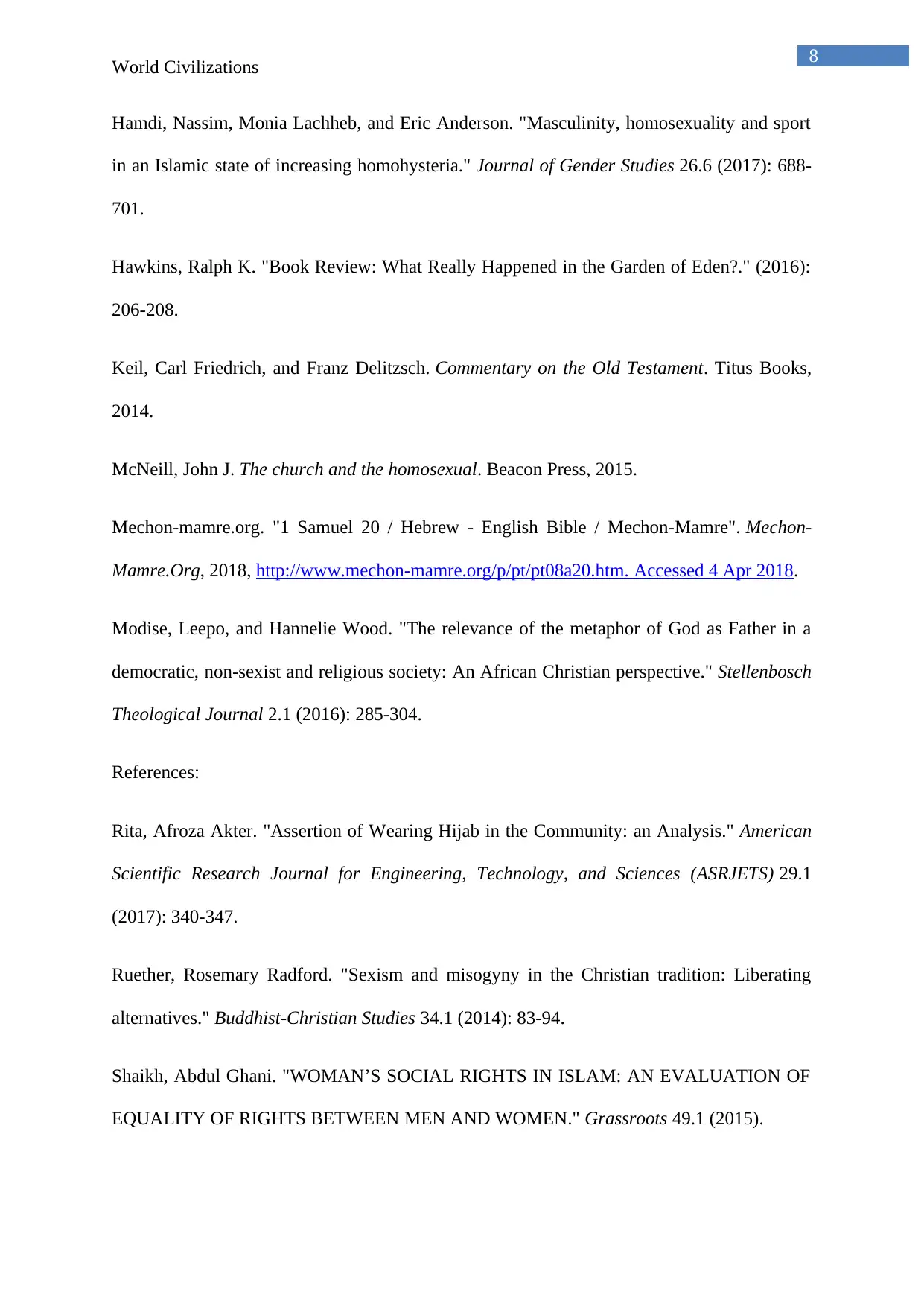
8
World Civilizations
Hamdi, Nassim, Monia Lachheb, and Eric Anderson. "Masculinity, homosexuality and sport
in an Islamic state of increasing homohysteria." Journal of Gender Studies 26.6 (2017): 688-
701.
Hawkins, Ralph K. "Book Review: What Really Happened in the Garden of Eden?." (2016):
206-208.
Keil, Carl Friedrich, and Franz Delitzsch. Commentary on the Old Testament. Titus Books,
2014.
McNeill, John J. The church and the homosexual. Beacon Press, 2015.
Mechon-mamre.org. "1 Samuel 20 / Hebrew - English Bible / Mechon-Mamre". Mechon-
Mamre.Org, 2018, http://www.mechon-mamre.org/p/pt/pt08a20.htm. Accessed 4 Apr 2018.
Modise, Leepo, and Hannelie Wood. "The relevance of the metaphor of God as Father in a
democratic, non-sexist and religious society: An African Christian perspective." Stellenbosch
Theological Journal 2.1 (2016): 285-304.
References:
Rita, Afroza Akter. "Assertion of Wearing Hijab in the Community: an Analysis." American
Scientific Research Journal for Engineering, Technology, and Sciences (ASRJETS) 29.1
(2017): 340-347.
Ruether, Rosemary Radford. "Sexism and misogyny in the Christian tradition: Liberating
alternatives." Buddhist-Christian Studies 34.1 (2014): 83-94.
Shaikh, Abdul Ghani. "WOMAN’S SOCIAL RIGHTS IN ISLAM: AN EVALUATION OF
EQUALITY OF RIGHTS BETWEEN MEN AND WOMEN." Grassroots 49.1 (2015).
World Civilizations
Hamdi, Nassim, Monia Lachheb, and Eric Anderson. "Masculinity, homosexuality and sport
in an Islamic state of increasing homohysteria." Journal of Gender Studies 26.6 (2017): 688-
701.
Hawkins, Ralph K. "Book Review: What Really Happened in the Garden of Eden?." (2016):
206-208.
Keil, Carl Friedrich, and Franz Delitzsch. Commentary on the Old Testament. Titus Books,
2014.
McNeill, John J. The church and the homosexual. Beacon Press, 2015.
Mechon-mamre.org. "1 Samuel 20 / Hebrew - English Bible / Mechon-Mamre". Mechon-
Mamre.Org, 2018, http://www.mechon-mamre.org/p/pt/pt08a20.htm. Accessed 4 Apr 2018.
Modise, Leepo, and Hannelie Wood. "The relevance of the metaphor of God as Father in a
democratic, non-sexist and religious society: An African Christian perspective." Stellenbosch
Theological Journal 2.1 (2016): 285-304.
References:
Rita, Afroza Akter. "Assertion of Wearing Hijab in the Community: an Analysis." American
Scientific Research Journal for Engineering, Technology, and Sciences (ASRJETS) 29.1
(2017): 340-347.
Ruether, Rosemary Radford. "Sexism and misogyny in the Christian tradition: Liberating
alternatives." Buddhist-Christian Studies 34.1 (2014): 83-94.
Shaikh, Abdul Ghani. "WOMAN’S SOCIAL RIGHTS IN ISLAM: AN EVALUATION OF
EQUALITY OF RIGHTS BETWEEN MEN AND WOMEN." Grassroots 49.1 (2015).
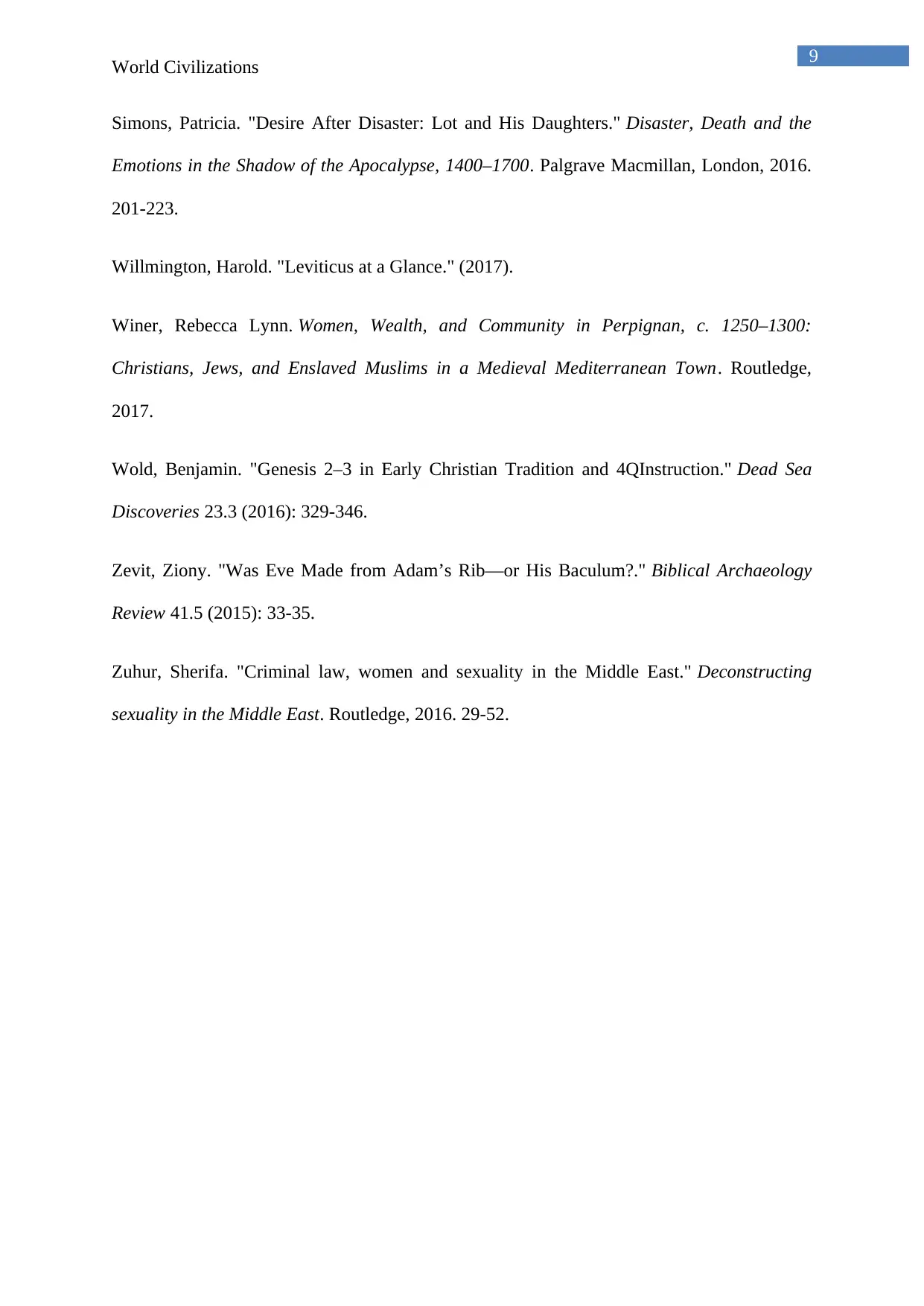
9
World Civilizations
Simons, Patricia. "Desire After Disaster: Lot and His Daughters." Disaster, Death and the
Emotions in the Shadow of the Apocalypse, 1400–1700. Palgrave Macmillan, London, 2016.
201-223.
Willmington, Harold. "Leviticus at a Glance." (2017).
Winer, Rebecca Lynn. Women, Wealth, and Community in Perpignan, c. 1250–1300:
Christians, Jews, and Enslaved Muslims in a Medieval Mediterranean Town. Routledge,
2017.
Wold, Benjamin. "Genesis 2–3 in Early Christian Tradition and 4QInstruction." Dead Sea
Discoveries 23.3 (2016): 329-346.
Zevit, Ziony. "Was Eve Made from Adam’s Rib—or His Baculum?." Biblical Archaeology
Review 41.5 (2015): 33-35.
Zuhur, Sherifa. "Criminal law, women and sexuality in the Middle East." Deconstructing
sexuality in the Middle East. Routledge, 2016. 29-52.
World Civilizations
Simons, Patricia. "Desire After Disaster: Lot and His Daughters." Disaster, Death and the
Emotions in the Shadow of the Apocalypse, 1400–1700. Palgrave Macmillan, London, 2016.
201-223.
Willmington, Harold. "Leviticus at a Glance." (2017).
Winer, Rebecca Lynn. Women, Wealth, and Community in Perpignan, c. 1250–1300:
Christians, Jews, and Enslaved Muslims in a Medieval Mediterranean Town. Routledge,
2017.
Wold, Benjamin. "Genesis 2–3 in Early Christian Tradition and 4QInstruction." Dead Sea
Discoveries 23.3 (2016): 329-346.
Zevit, Ziony. "Was Eve Made from Adam’s Rib—or His Baculum?." Biblical Archaeology
Review 41.5 (2015): 33-35.
Zuhur, Sherifa. "Criminal law, women and sexuality in the Middle East." Deconstructing
sexuality in the Middle East. Routledge, 2016. 29-52.
1 out of 10
Your All-in-One AI-Powered Toolkit for Academic Success.
+13062052269
info@desklib.com
Available 24*7 on WhatsApp / Email
![[object Object]](/_next/static/media/star-bottom.7253800d.svg)
Unlock your academic potential
© 2024 | Zucol Services PVT LTD | All rights reserved.